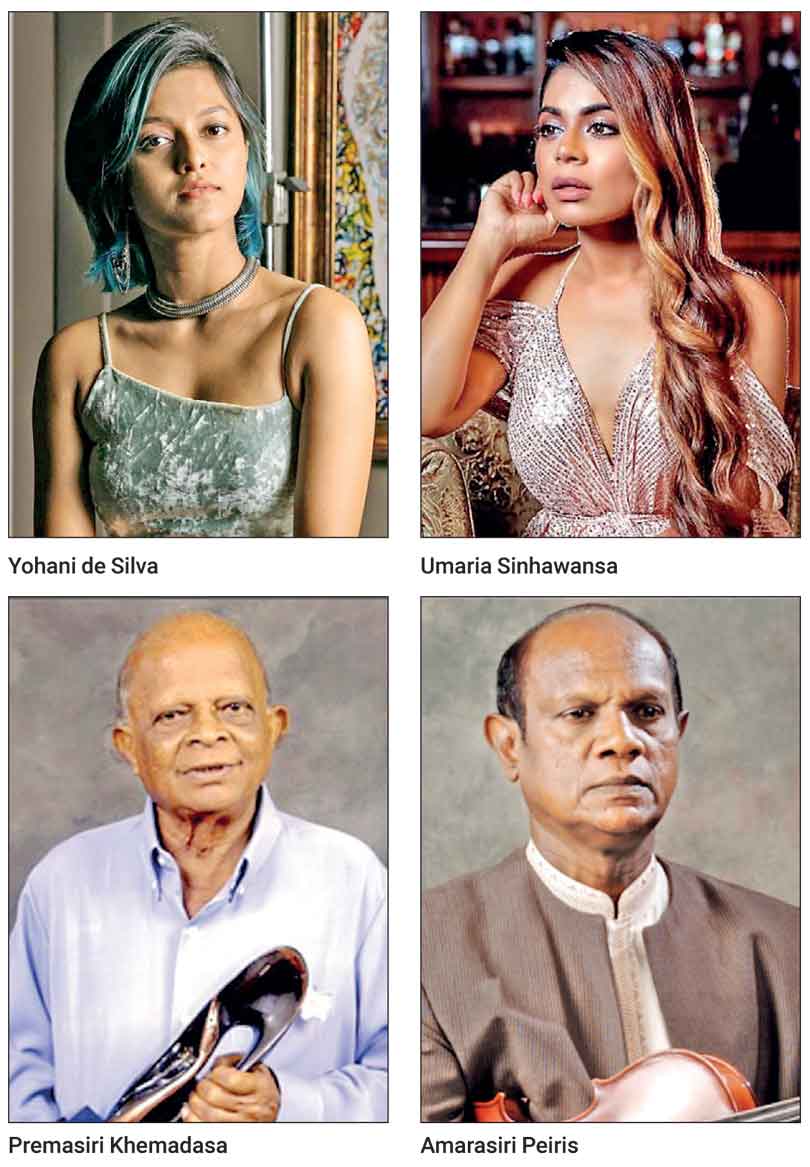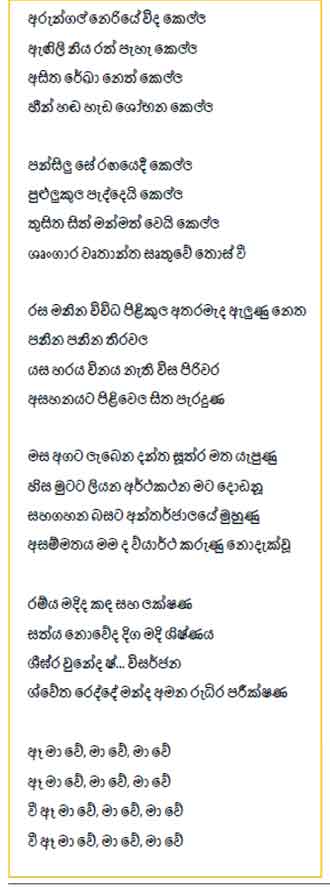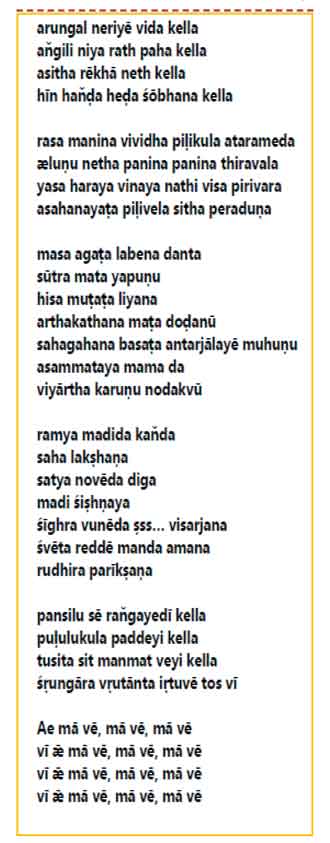Sunday Apr 13, 2025
Sunday Apr 13, 2025
Tuesday, 5 November 2024 00:04 - - {{hitsCtrl.values.hits}}

 Sri Lanka is an island. Such a geographical feature comes with good and bad. Physical isolation or not having a boundary shared with a neighbouring country gave us peace of mind on border conflicts. However, it did not prevent us from getting invaded by the nations with naval powers. Further, it allowed us to create unique cultural habits blended with the natural environment. We have our own Lepidoptera, birds, and flora and fauna. Free flow of people across the borders would have challenged our ethnic identities. In such a connected country, the competition among migrants for limited resources would have been high, causing tensions among people to win their fair share.
Sri Lanka is an island. Such a geographical feature comes with good and bad. Physical isolation or not having a boundary shared with a neighbouring country gave us peace of mind on border conflicts. However, it did not prevent us from getting invaded by the nations with naval powers. Further, it allowed us to create unique cultural habits blended with the natural environment. We have our own Lepidoptera, birds, and flora and fauna. Free flow of people across the borders would have challenged our ethnic identities. In such a connected country, the competition among migrants for limited resources would have been high, causing tensions among people to win their fair share.
However, nature has a levelling treatment of all environments. Isolation comes with many disadvantages. We did not have everything in-house to survive humanely. To have everything, the inhabitants must work hard with focused minds. Unfortunately, we were not such a nation. Our cultural habits, religious behaviours and even national attire made us a nation epitomised by simple, easy-going, slow-responsive and non-progressive. So, we just imported what we did not have.
We will surely find that others are different during the integration phase. Hence, to co-exist, we must build accommodative forbearance within our minds. As a nation trapped on an island, we could not build open-mindedness. We became too nationalistic and religious-egoistic. Advanced technological developments do not happen in isolation as the investigation and development process requires the study of existing technological benchmarks. Hence, we are stuck behind with outdated technologies in isolation.
Social amelioration
The non-existence of the free and natural exchange of knowledge, ideas, and cultural elements to enrich each other, due to this geographical isolation, is my main concern. If we had land connections with other countries, there would have been transport links for people to travel across borders and bring back good foreign cultural elements. Pessimists may view this as cultural contamination and loss of economic opportunities. In the new world, the regional powers dictate control over the less powerful nations in a region. Being an island does not immune us from this control. As a small nation, Sri Lanka has already been  under the influence of regional superpowers India and China. It comes down to our choice. Do we want to be a part of the world and thrive or hide inside an ocean and get extinct?
under the influence of regional superpowers India and China. It comes down to our choice. Do we want to be a part of the world and thrive or hide inside an ocean and get extinct?
I see a distinct advantage to society by having a high tolerance level to appreciate different ethnic behaviours and cultural norms of others. Having competitiveness among people to outshine in society would have made all of us more ambitious and confident to roam in unchartered territories. Of course, an independent country needs a governance framework of social order, norms, and certain regulations. It will keep unique cultural elements intact and avoid the exploitation of vulnerable members of society. It is a balance between the wild donkey freedom and the democratic freedom.
My focus today is to share my views and experiences about the status of the Sri Lankan creative industry.
Heroes of creative industry
I have the habit of reading, writing, and observing the behaviours of others. I observed the societal and personal behaviours of revered figures in the Sri Lankan creative industry with awe. My personal life heroes included Punya Heendeniya, Anula Karunathilaka, Swarna Mallawarachchi, Gamini Fonseka, Tony Ranasinghe, and Joe Abeywickrama due to their intuitive performing talents. I admired how they gradually broke the shackles of the South Indian storytelling genre, artificial movie studio settings and over-acting directives generated by the South Indian movie directors and producers. I would name W.D. Amaradewa, Nanda Malani, Karunarathna Divulgane and Amarasiri Peiris as my favourite singers.
I reckon our veteran artists would have been better recognised internationally if they had a continual association with international artists by visiting and living there for extended times and learning the “cultural languages” of the others. Our artists cannot learn this lesson by merely visiting foreign countries to do a concert in front of Sri Lankan expatriates. They must domicile on foreign soil for a specific period and produce joint artistic works with international artists while learning the cultural elements of an unfamiliar environment. If done, they could have harnessed their potential to become world artists without boundaries.
The popular misconceptions among people are that if Sri Lanka is infrastructurally connected to India to allow free movement across the border, Sri Lanka will lose its character of independence, Indian culture would consume our culture and we would live permanently under the shadow of India. If this is true, many countries are not independent countries. It is a fact that India has become a regional superpower. India does not need land connections to exert dominance over neighbouring countries. It has already happened. On the contrary, if such an exchange of cultural elements has occurred, based on ‘our will’ with a deeper understanding of what we do, our good cultural elements would have been enriched to a higher level through cultural interactions.
This is not a forced assimilation. We decide what to be embraced and what to be rejected. Instead, what happened was that the Indian businesspeople with limited artistic talents landed in Sri Lanka as “artists” and forcefully established a poor-quality creative industry, exploiting the artistically illiterate masses.
What were the outcomes of this isolation? We have become a nation of intolerant, and insensitive people. I would say, we are a bit over-confident ourselves believing we know better than others. I feel this from some responses to my article on the societal role of professionals. Our elders and teachers never taught us to be innovative and free thinkers. Now, the Y and Z generations are trying to break the socio-religious and political shackles and become free thinkers and dream chasers.
The revolt
Gen Y and Z generations in Sri Lanka led a public revolt a few years ago. They demanded a System Change. The public understood the problems and the symptoms. However, they had no idea about the solutions. They thought it was about the change of political culture. On the contrary, the youth demanded changes to all facets of social life. The main reasons for the society’s inability to understand the nature of the system change were their generational practices of rote learning, the love affair with traditional social norms, and political illiteracy. The Pre-Gen Y accepted anything implanted upon them by others without questioning. The uninquisitive minds could be easily deceived and manipulated by words, stories, and deeds. In their world, questioning the status quo was a revolutionary act and a violation of social norms.
Gen Y and Z had enough and decided to jump the island’s geographical boundary physically and technologically. They have spread their global reach using social media. Social media characterised by multi-communication loops has exposed them to a new world. Now, they question the previous generation asking “Why didn’t you tell us there is a huge world full of marvellous people, technology, art, and cultural elements?
Creativity shock
In the creative industry, the veterans have not anticipated this rapid transformation of Gen Y and Z. The veterans were just blinded by over-rated self-evaluation of their creative works.  They were happy to sell their works to the highest local bidders using their social status, not necessarily based on the artistic value. In this process, they neglected their moral duty to guide and nurture the next generation. So, each new generation lost its way in the creative industry. We have a bankruptcy in creativity.
They were happy to sell their works to the highest local bidders using their social status, not necessarily based on the artistic value. In this process, they neglected their moral duty to guide and nurture the next generation. So, each new generation lost its way in the creative industry. We have a bankruptcy in creativity.
The danger of Gen Y and Z’s activities is their boldness to embrace the good and the bad as a mix as no one taught them how to distinguish the good from bad. Before teaching the younger generation, the veterans must know what is good and bad in the international creative industry. The veterans don’t know enough to make that call as they are already victims of long social and cultural isolation.
Creative industry
I am a Sinhala and old Hindi music lover. My focus is on the total quality of the song and the lasting experience generated from the song. I do not focus on the popularity or social status of the singer. I appreciate thought-provoking lyrics, creative music, catchy melodies, and soulful singing. In Australia, youngsters of Sri Lankan background have shown interest in music. They have rich Western music interests. Recently, I asked them their opinion on Sri Lankan songs. Their responses were “too slow, depressing, no fun, too much string instrument use, limited range chord selection, no saxophone, no Western style drum use”. This list went on.
It is not about what or who is right. The message is that the perception of the audience matters. If our artists, young and old expanded their wings internationally, integrated and assimilated with the rest of the world, they would have understood the international taste. Our Gen Y and Z in Sri Lanka are increasingly rejecting established local music genres and starting to appreciate international musical genres.
Khemadasa factor
One person who understood that there was a high-quality artistic world beyond the island’s boundaries was the late Premasiri Khemadasa. In my view, even, the great Maestro Amaradeva could not walk out of the classical “raghadharee” Hindustani musical shadow until Khemadasa dragged him out. Without Khemadasa, we would not have Amarasiri Peiris as a singer, but as a violinist. We would not have experienced opera, symphonies, and cantata blended with folk musical roots in Sri Lanka. Khemadasa broke the island mentality, acquired musical elements from other cultures and mixed those with local elements to create lasting musical products.
So far, other musicians are just imitators and followers of Khemadasa and Rahul Dev Burman (the Indian equivalent). I reckon, only great musician Sarath Dassanayake came close to Khemadasa’s creativity. Khemadasa was even ready to use the sound of a bomb explosion if it was the sound he wanted. Rahul Dev Burman created sounds from scrap metals and water pots. Khemadasa had three musical development phases and he improved his musical style in each phase. If Khemadasa is alive, he would have pushed Sri Lankan music to the international arena by selecting a bunch of young singers, like A.R. Rahman did in India.
New talents
I wanted to see hugely talented Umaria Sinhawansa break into the international arena before anyone else as she had all the ingredients to be an international artist. However, it has not happened yet. She could not transfer her skills laterally to match international flavours. I reckon she does not have a good business plan and a high-calibre content manager to help her in this journey. It was Yohani De Silva who broke into the international arena via India. I do not want to repeat the same I wrote about Yohani before. However, I want to remind my belief in her intuitive awareness of her limitations. She continually worked hard to get the best out of her limited abilities. She found an able content manager in Dilanjan Seneviratne as her mentor. This duo produced the magic.
Nominee for Best Global Music Album
Yohani recently revealed that her debut album ‘Kella’ has been accepted for consideration in the Best Global Music Album category at the 67th Annual Grammy Awards. The award for Best Global Music Album is reserved for international performers exhibiting “non-European, indigenous traditions”. I wish her the best of luck and the whole nation must wish her success. Despite whether she would receive further accolades or not, just the acceptance as a nominee for this prestigious award itself is a win for her and for Sri Lanka.
A few months ago, Yohani dropped a bomb on the Sri Lankan creative industry by releasing her song Kella. It was a modern rap song sung by Yohani within her limited vocal range and she did it expertly. The melody and music had an international signature. The video choreography has been done neatly with controlled seductive moves and careful choice of outfits and ornaments.
Local public and musical veterans outrightly rejected the song and video criticising singing limitations, challenges to cultural norms and more particularly the saucy lyrics. Dilanjan has written the lyrics with some input from Yohani. However, both defended publicly the well-thought-out choice of words for the song.
Yohani explained that the song was an artistic expression of her experience as a girl who entered the local music industry. There was a big backlash in the social media to undermine her effort and the haters even talked about her body shape attributing to specific words in the song, to belittle her universal message. One critic misinterpreted the song as an attack on the youth of “Aragalaya”. It prompted Dilanjan to attend a social media interview to quash such interpretations. Now, she has conquered the world of music through the song Kella. The dogs bark, but the caravan moves on.
I believe that Yohani might have asked Dilanjan to write this way because she has high confidence in her content manager’s talent. He had a complete understanding of what she went through. Yohani has a specific skill set. So, the lyrics and the melody had to be exactly in line with her skill range. Dilanjan did this expertly. Yohani and Dilanjan wanted to hit the most vulnerable point of male haters. Irrespective of the facts around the size of male body parts, they used the established perception in society to their advantage. It worked exactly the way they intended to generate humiliation among her male haters. Dilanjan used the Sinhala word “Shishnaya” appeared in the classical Sinhala dictionary. It was not an obscene word. I reproduce the copyrighted lyrics of Kella song here, acknowledging its ownership to Dilanjan and Yohani as lyricists.
I must confess that Dilanjan’s style of writing is different to mine. I prefer the use of traditional language. I do not consider myself a talented lyricist although I wrote four songs (https://www.youtube.com/@janaka_seneviratneXX15?app=desktop). I only write for self-contentment. All my song videos come with English translations. It is for a wider cross-section to understand my messages. I learnt it from Prof. Sunil Ariyaratne, by studying a booklet of Sinhala lyrics with the English translations for ‘Hemanthayedi’ Music Cassette released by Nanda Malani in 1985. It is nice to note the use of English translation for Yohani’s song videos.
Way forward for our creative industry
The creative industry consists of design, music, architecture, publishing, music and video, crafts, visual arts, fashion, TV and radio, advertising, literature, computer games and performing arts disciplines.
In developed countries like the United Kingdom, 1 in 8 businesses is a creative industry business. However, in the UK, 95% of businesses employ fewer than 10 people. It indicates the business spread and the people’s involvement. I do not have similar statistics for the Sri Lankan creative industry. However, I assume that Sri Lanka has more freelance artists serving many small creative industry businesses. Internationally acclaimed Sri Lanka entrepreneurship in the creative industry is minimal.
My limited experience with the Sri Lankan creative industry does not have fond memories. It has been transformed into a throat-cuttingly competitive, money-hungry, abusive, unruly, unprofessional, and unethical industry. In a failed State, all disciplines collapse as a heap. The majority of well-known artists are now in the twilight of their lives. They have no interest in facilitating the younger generation to improve the quality of their musical products. Their sole focus is to earn as much as possible before nature’s fate. I remember contacting an award-winning singer and a composer to initiate a song project. They wanted one million Sri Lankan rupees to produce the audio track only. They did not bother to ask for qualitative details of the song. I rejected their offer politely based on my moral principles. Their greed for money over quality was amply revealed.
In my view, the Government should facilitate the industry for young people to try artistic experiments in various branches of the creative industry. The Government should bring veteran artists to hold public workshops to share their wealth of experience and expertise with the younger generation. This will encourage young people to produce innovative artistic outcomes. The Government can establish cultural know-how exchange programs with other countries. The importance of using correct language, cultural elements, and understanding of international culture and artistic works must be inculcated into young minds, giving them the freedom of expression. Our diplomatic missions should talk to international artists and encourage them to hold such workshops for young artists. Rich international artists would share their knowledge with the young generation in nations like ours. It is a matter of having a proper approach with a genuine interest and a long-term plan.
(The writer is a professional Engineer working in the Australian NSW Local Government sector. He intends to share his views on various social development areas, in addition to his chosen professional discipline to inspire youth to think differently. He is contactable via [email protected].)
Discover Kapruka, the leading online shopping platform in Sri Lanka, where you can conveniently send Gifts and Flowers to your loved ones for any event including Valentine ’s Day. Explore a wide range of popular Shopping Categories on Kapruka, including Toys, Groceries, Electronics, Birthday Cakes, Fruits, Chocolates, Flower Bouquets, Clothing, Watches, Lingerie, Gift Sets and Jewellery. Also if you’re interested in selling with Kapruka, Partner Central by Kapruka is the best solution to start with. Moreover, through Kapruka Global Shop, you can also enjoy the convenience of purchasing products from renowned platforms like Amazon and eBay and have them delivered to Sri Lanka.
Discover Kapruka, the leading online shopping platform in Sri Lanka, where you can conveniently send Gifts and Flowers to your loved ones for any event including Valentine ’s Day. Explore a wide range of popular Shopping Categories on Kapruka, including Toys, Groceries, Electronics, Birthday Cakes, Fruits, Chocolates, Flower Bouquets, Clothing, Watches, Lingerie, Gift Sets and Jewellery. Also if you’re interested in selling with Kapruka, Partner Central by Kapruka is the best solution to start with. Moreover, through Kapruka Global Shop, you can also enjoy the convenience of purchasing products from renowned platforms like Amazon and eBay and have them delivered to Sri Lanka.